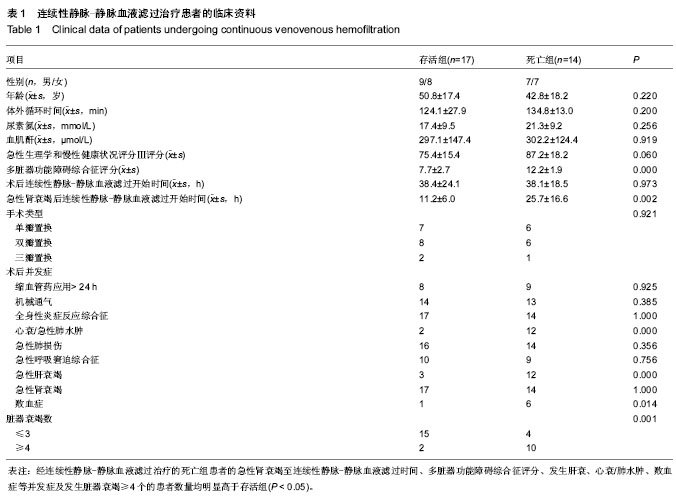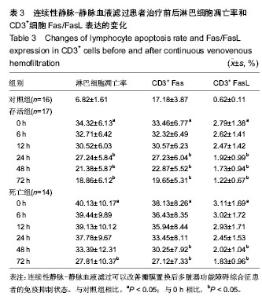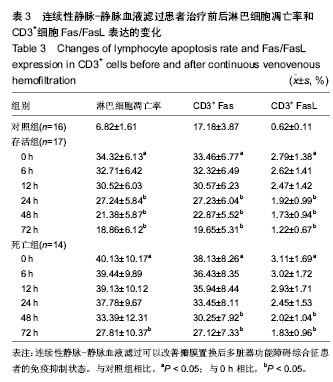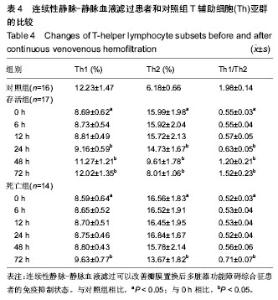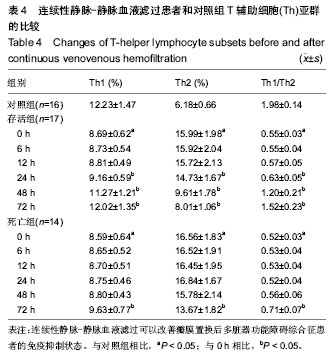Chinese Journal of Tissue Engineering Research ›› 2014, Vol. 18 ›› Issue (5): 712-717.doi: 10.3969/j.issn.2095-4344.2014.05.010
Previous Articles Next Articles
Continuous venovenous hemofiltration after cardiac valve replacement
Zhao Xiao-juan1, 2, Liu Hong-bao2, Sun Shi-ren2, Zhang Peng2, Wang Han-min2, Huang Chen2
- 1Department of Nephrology, Yan’an People’s Hospital, Yan’an 716000, Shaanxi Province, China; 2Department of Nephrology, Xijing Hospital, the Fourth Military Medical University of Chinese PLA, Xi’an 710032, Shaanxi Province, China
-
Revised:2014-01-18Online:2014-01-29Published:2014-01-29 -
Contact:Liu Hong-bao, M.D., Attending physician, Lecturer, Department of Nephrology, Xijing Hospital, the Fourth Military Medical University of Chinese PLA, Xi’an 710032, Shaanxi Province, China -
About author:Zhao Xiao-juan, Attending physician, Department of Nephrology, Yan’an People’s Hospital, Yan’an 716000, Shaanxi Province, China; Department of Nephrology, Xijing Hospital, the Fourth Military Medical University of Chinese PLA, Xi’an 710032, Shaanxi Province, China -
Supported by:the National Natural Science Foundation of China, No. 81370016 and 81000309; Excellent Youths of Chinese Medical Doctor Association, No. 2012
CLC Number:
Cite this article
Zhao Xiao-juan, Liu Hong-bao, Sun Shi-ren, Zhang Peng, Wang Han-min, Huang Chen . Continuous venovenous hemofiltration after cardiac valve replacement[J]. Chinese Journal of Tissue Engineering Research, 2014, 18(5): 712-717.
share this article
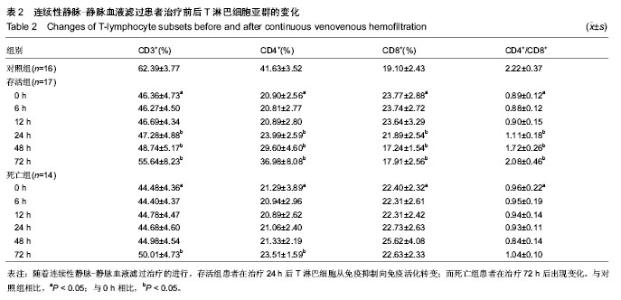
2.2 连续性静脉-静脉血液滤过对T淋巴细胞亚群的影响 连续性静脉-静脉血液滤过治疗前,存活组和死亡组患者CD3+,CD4+ T淋巴细胞百分数和CD4+/CD8+比值均低于对照组(P < 0.05),而CD8+ T淋巴细胞百分数高于对照组(P < 0.05),说明2组患者在T淋巴细胞亚群分布上处于抑制状态。随着连续性静脉-静脉血液滤过治疗的进行,存活组患者治疗24 h后CD3+,CD4+ T淋巴细胞百分数和CD4+/CD8+比值逐渐增高(P < 0.05),而CD8+ T淋巴细胞百分数逐渐降低(P < 0.05);但死亡组患者CD3+,CD4+ T淋巴细胞百分数在治疗72 h后才明显增高(P < 0.05),而CD8+ T淋巴细胞百分数和CD4+/CD8+比值在治疗的72 h内无显著性变化(P > 0.05;表2)。"
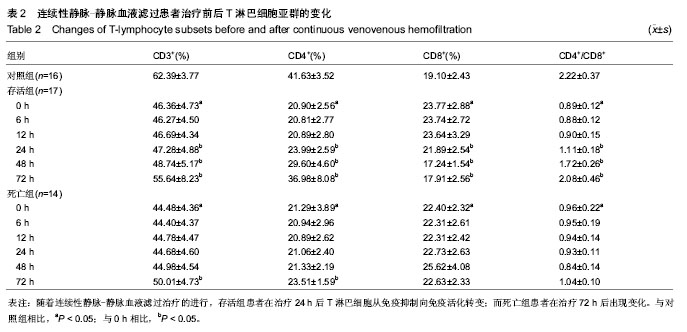
| [1] Tovey L, Dickie H, Gangi S, et al. Beyond the randomized clinical trial: citrate for continuous renal replacement therapy in clinical practice. Nephron Clin Pract. 2013;124(1-2): 119-123. [2] 张晓东,李小萍,宋洁,等.半永久双腔中心静脉导管维持性血液透析患者的微炎症状态[J].中国组织工程研究, 2013,17(5): 913-919.[3] 吴道诩,徐岩.维持性血液透析患者的动脉粥样硬化[J].中国组织工程研究,2013,17(31):5666-5672.[4] 崔岩,魏丽丽,李琳,等.个体及集体干预对维持性血液透析患者生存质量的影响[J].中国组织工程研究,2013,17(44):7815-7820.[5] 曹宁.肾移植前后未透析与透析效果及血液透析与腹膜透析的对比分析[J].中国组织工程研究,2012,16(18):3357-3364.[6] 曹宁.肾功能衰竭患者采用不同血液透析膜材料的生物相容性对比分析[J].中国组织工程研究,2012,16(25):4727-4734.[7] 王涛,张凡,魏萌,等.头孢他啶-肝素封管预防血液透析患者深静脉置管感染[J].中国组织工程研究,2012,16(31):5759-5762.[8] 沈蓓莉,曲青山,苗书斋,等.不同血液净化方式与移植肾功能的延迟恢复[J].中国组织工程研究,2012,16(31):5715-5719.[9] Franke A, Lante W, Kurig E, et al. Hyporesponsiveness of T cell subsets after cardiac surgery: a product of altered cell function or merely a result of absolute cell count changes in peripheral blood? Eur J Cardiothorac Surg. 2006;30(1):64-71. [10] 程光存,程明光,汤丹丹,等.改良心肌保护液在婴幼儿心内直视手术中的应用[J].中国组织工程研究,2013,17(31):5659-5665.[11] 李金友,李彤,于美丽,等.氧化海藻酸钠应用于体外循环管路[J].中国组织工程研究,2013,17(34):6159-6165.[12] 于广栋,李彤,高文卿,等.体外循环聚氯乙烯管路地塞米松涂层的性能[J].中国组织工程研究,2013,17(12):2177-2184.[13] 邵连彬,杨晓刚,杨海平,等.人工瓣膜置换体外循环过程中痰热清注射液的肺保护[J].中国组织工程研究,2013,17(5):843-850.[14] 周涛,何巍,谢晓勇.老年患者浅低温心脏不停跳瓣膜置换中的心肌保护[J].中国组织工程研究,2012,16(18):3259-3262.[15] 渠川铮,张瑞英,相开放.心脏瓣膜置换围手术期血糖控制对血乳酸水平的影响[J].中国组织工程研究,2012,16(53):9955-9959.[16] 谢晓勇,何巍,郑宝石,等.浅低温体外循环心脏不停跳条件下瓣膜置换的肺保护[J].中国组织工程研究,2012,16(18):3267-3271.[17] Lugones F, Chiotti G, Carrier M, et al. Continuous renal replacement therapy after cardiac surgery. Review of 85 cases. Blood Purif. 2004;22(3):249-255. [18] Santiago MJ, López-Herce J, Urbano J, et al. Continuous renal replacement therapy in children after cardiac surgery. J Thorac Cardiovasc Surg. 2013;146(2):448-454. [19] Morabito S, Pistolesi V, Tritapepe L, et al. Regional citrate anticoagulation in cardiac surgery patients at high risk of bleeding: a continuous veno-venous hemofiltration protocol with a low concentration citrate solution. Crit Care. 2012; 16(3):R111. [20] Miyamoto T, Yoshimoto A, Tatsu K, et al. Zero mortality of continuous veno-venous hemodiafiltration with PMMA hemofilter after pediatric cardiac surgery. Ann Thorac Cardiovasc Surg. 2011;17(4):352-355.[21] 王今达,王宝恩.多脏器功能失常综合征(MODS)病情分期诊断及严重程度评分标准[J].中国危重病急救医学,1995,7(6):346-349.[22] Knaus WA, Wagner DP, Draper EA, et al. The APACHE III prognostic system. Risk prediction of hospital mortality for critically ill hospitalized adults. Chest. 1991;100(6):1619- 1636.[23] Clermont G, Vergely C, Jazayeri S, et al. Systemic free radical activation is a major event involved in myocardial oxidative stress related to cardiopulmonary bypass. Anesthesiology. 2002;96(1):80-87.[24] 刘宏宝,王汉民,李振江,等.连续性血液净化对心脏术后多器官功能障碍综合征存活者与死亡者血浆炎性介质的影响[J].中国急救医学,2005,25(7):475-478.[25] 王汉民,连耀国,刘宏宝,等.连续性血液净化对心脏术后多脏器功能障碍综合征患者炎性介质和氧化应激的影响[J].中国血液净化,2006,5(11):769-772.[26] 刘宏宝,王汉民,李振江,等.连续性肾脏替代治疗在心脏术后MODS合并ARF中的应用[J].中国血液净化,2005,4(4):201-204.[27] von Dossow V, Baehr N, Moshirzadeh M, et al. Clonidine attenuated early proinflammatory response in T-cell subsets after cardiac surgery. Anesth Analg. 2006;103(4):809-814.[28] Zedler S, Bone RC, Baue AE, et al. T-cell reactivity and its predictive role in immunosuppression after burns. Crit Care Med. 1999;27(1):66-72.[29] Brod SA, Nelson LD, Khan M, et al. Increased in vitro induced CD4+ and CD8+ T cell IFN-gamma and CD4+ T cell IL-10 production in stable relapsing multiple sclerosis. Int J Neurosci. 1997;90(3-4):187-202. [30] Rink L, Seyfarth M. Characteristics of immunologic test values in the elderly. Z Gerontol Geriatr. 1997;30(3):220-225. [31] Barlow Y. T lymphocytes and immunosuppression in the burned patient: a review. Burns. 1994;20(6):487-490.[32] Brunner M, Krenn C, Roth G, et al. Increased levels of soluble ST2 protein and IgG1 production in patients with sepsis and trauma. Intensive Care Med. 2004;30(7):1468-1473. [33] Schmidt DD, Schmidt PM, Crabtree BF, et al. The temporal relationship of psychosocial stress to cellular immunity and herpes labialis recurrences. Fam Med. 1991;23(8):594-599. [34] O'Sullivan ST, O'Connor TP. Immunosuppression following thermal injury: the pathogenesis of immunodysfunction. Br J Plast Surg. 1997;50(8):615-623.[35] Brunner M, Krenn C, Roth G, et al. Increased levels of soluble ST2 protein and IgG1 production in patients with sepsis and trauma. Intensive Care Med. 2004;30(7):1468-1473. [36] 刘宏宝,王汉民,李振江,等.连续性血液净化防治心脏术后患者多器官功能障碍综合征效果的评价[J].肾脏病与透析肾移植杂志, 2004,13(5):414-418. |
| [1] | Chen Ziyang, Pu Rui, Deng Shuang, Yuan Lingyan. Regulatory effect of exosomes on exercise-mediated insulin resistance diseases [J]. Chinese Journal of Tissue Engineering Research, 2021, 25(25): 4089-4094. |
| [2] | Chen Yang, Huang Denggao, Gao Yuanhui, Wang Shunlan, Cao Hui, Zheng Linlin, He Haowei, Luo Siqin, Xiao Jingchuan, Zhang Yingai, Zhang Shufang. Low-intensity pulsed ultrasound promotes the proliferation and adhesion of human adipose-derived mesenchymal stem cells [J]. Chinese Journal of Tissue Engineering Research, 2021, 25(25): 3949-3955. |
| [3] | Yang Junhui, Luo Jinli, Yuan Xiaoping. Effects of human growth hormone on proliferation and osteogenic differentiation of human periodontal ligament stem cells [J]. Chinese Journal of Tissue Engineering Research, 2021, 25(25): 3956-3961. |
| [4] | Sun Jianwei, Yang Xinming, Zhang Ying. Effect of montelukast combined with bone marrow mesenchymal stem cell transplantation on spinal cord injury in rat models [J]. Chinese Journal of Tissue Engineering Research, 2021, 25(25): 3962-3969. |
| [5] | Gao Shan, Huang Dongjing, Hong Haiman, Jia Jingqiao, Meng Fei. Comparison on the curative effect of human placenta-derived mesenchymal stem cells and induced islet-like cells in gestational diabetes mellitus rats [J]. Chinese Journal of Tissue Engineering Research, 2021, 25(25): 3981-3987. |
| [6] | Hao Xiaona, Zhang Yingjie, Li Yuyun, Xu Tao. Bone marrow mesenchymal stem cells overexpressing prolyl oligopeptidase on the repair of liver fibrosis in rat models [J]. Chinese Journal of Tissue Engineering Research, 2021, 25(25): 3988-3993. |
| [7] | Liu Jianyou, Jia Zhongwei, Niu Jiawei, Cao Xinjie, Zhang Dong, Wei Jie. A new method for measuring the anteversion angle of the femoral neck by constructing the three-dimensional digital model of the femur [J]. Chinese Journal of Tissue Engineering Research, 2021, 25(24): 3779-3783. |
| [8] | Meng Lingjie, Qian Hui, Sheng Xiaolei, Lu Jianfeng, Huang Jianping, Qi Liangang, Liu Zongbao. Application of three-dimensional printing technology combined with bone cement in minimally invasive treatment of the collapsed Sanders III type of calcaneal fractures [J]. Chinese Journal of Tissue Engineering Research, 2021, 25(24): 3784-3789. |
| [9] | Qian Xuankun, Huang Hefei, Wu Chengcong, Liu Keting, Ou Hua, Zhang Jinpeng, Ren Jing, Wan Jianshan. Computer-assisted navigation combined with minimally invasive transforaminal lumbar interbody fusion for lumbar spondylolisthesis [J]. Chinese Journal of Tissue Engineering Research, 2021, 25(24): 3790-3795. |
| [10] | Hu Jing, Xiang Yang, Ye Chuan, Han Ziji. Three-dimensional printing assisted screw placement and freehand pedicle screw fixation in the treatment of thoracolumbar fractures: 1-year follow-up [J]. Chinese Journal of Tissue Engineering Research, 2021, 25(24): 3804-3809. |
| [11] | Shu Qihang, Liao Yijia, Xue Jingbo, Yan Yiguo, Wang Cheng. Three-dimensional finite element analysis of a new three-dimensional printed porous fusion cage for cervical vertebra [J]. Chinese Journal of Tissue Engineering Research, 2021, 25(24): 3810-3815. |
| [12] | Wang Yihan, Li Yang, Zhang Ling, Zhang Rui, Xu Ruida, Han Xiaofeng, Cheng Guangqi, Wang Weil. Application of three-dimensional visualization technology for digital orthopedics in the reduction and fixation of intertrochanteric fracture [J]. Chinese Journal of Tissue Engineering Research, 2021, 25(24): 3816-3820. |
| [13] | Sun Maji, Wang Qiuan, Zhang Xingchen, Guo Chong, Yuan Feng, Guo Kaijin. Development and biomechanical analysis of a new anterior cervical pedicle screw fixation system [J]. Chinese Journal of Tissue Engineering Research, 2021, 25(24): 3821-3825. |
| [14] | Lin Wang, Wang Yingying, Guo Weizhong, Yuan Cuihua, Xu Shenggui, Zhang Shenshen, Lin Chengshou. Adopting expanded lateral approach to enhance the mechanical stability and knee function for treating posterolateral column fracture of tibial plateau [J]. Chinese Journal of Tissue Engineering Research, 2021, 25(24): 3826-3827. |
| [15] | Zhu Yun, Chen Yu, Qiu Hao, Liu Dun, Jin Guorong, Chen Shimou, Weng Zheng. Finite element analysis for treatment of osteoporotic femoral fracture with far cortical locking screw [J]. Chinese Journal of Tissue Engineering Research, 2021, 25(24): 3832-3837. |
| Viewed | ||||||
|
Full text |
|
|||||
|
Abstract |
|
|||||

